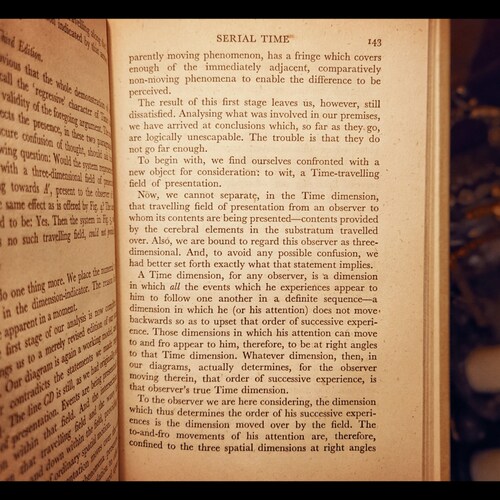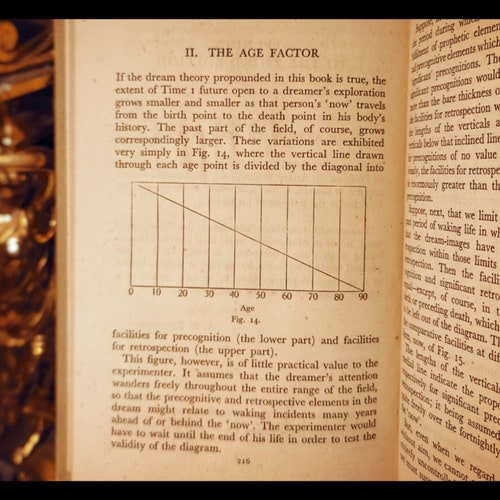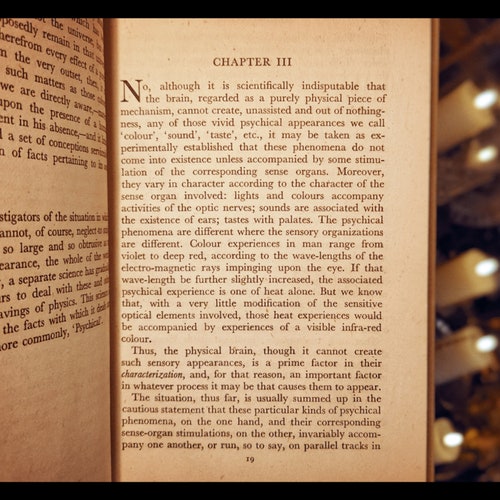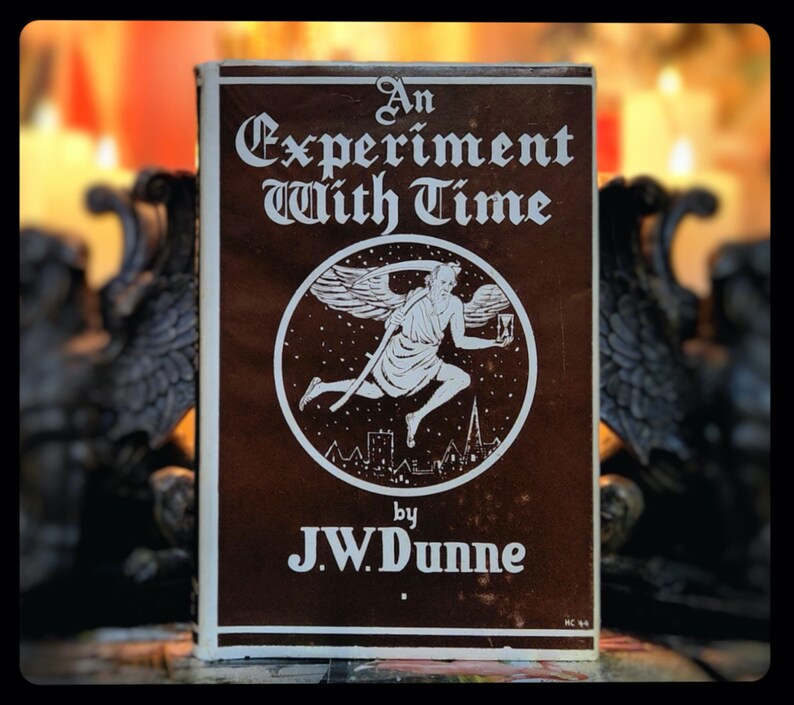PSYCHISM, CONSCIOUSNESS, DREAMS, THE FOURTH DIMENSION, PRECOGNITION, DIVINATION, & MUCH MORE
A RARE & GENUINE 1944 HARDCOVER EDITION WITH THE ORIGINAL DUST JACKET IN VERY GOOD CONDITION
An Experiment with Time is a book by the British soldier, aeronautical engineer, and philosopher J. W. Dunne about his precognitive dreams and a theory of time which he later called "Serialism". First published in March 1927, the book was widely read. Although never accepted by mainstream science, it has influenced imaginative literature ever since.
An Experiment with Time discusses two main topics.
The first half of the book describes a number of precognitive dreams, most of which Dunne himself had experienced. His key conclusion was that such precognitive visions foresee future personal experiences by the dreamer and not more general events.
The second half develops a theory to try and explain them. Dunne's starting point is the observation that the moment of "now" is not described by science. Contemporary science described physical time as a fourth dimension and Dunne's argument led to an endless sequence of higher dimensions of time to measure our passage through the dimension below. Accompanying each level was a higher level of consciousness. At the end of the chain was a supreme ultimate observer.
According to Dunne, our wakeful attention prevents us from seeing beyond the present moment, whilst when dreaming that attention fades and we gain the ability to recall more of our timeline. This allows fragments of our future to appear in pre-cognitive dreams, mixed in with fragments or memories of our past. Other consequences include the phenomenon known as deja vu and the existence of life after death.
Dreams and the experiment
Following a discussion of brain function in which Dunne expounds mind-brain parallelism and highlights the problem of subjective experience, he gives anecdotal accounts of precognitive dreams which, for the most part, he himself had experienced.
The first he records occurred in 1898, in which he dreamed of his watch stopping at an exact time before waking up and finding that it had in fact done so. Later dreams appeared to foretell several major disasters; a volcanic eruption in Martinique, a factory fire in Paris, and the derailing of the Flying Scotsman express train from the embankment approaching the Forth Railway Bridge in Scotland.
Dunne tells how he sought to make sense of these dreams, coming slowly to the conclusion that they foresaw events from his own future, such as reading a newspaper account of a disaster rather than foreseeing the disaster itself. In order to try and prove this to his satisfaction, he developed the experiment which gives the book its title. He kept a notepad by his bedside and wrote down details of any dreams immediately on waking, then later went back and compared them to subsequent events in his life. He also persuaded some friends to try the same experiment, as well as experimenting on himself with waking reveries approaching a hypnagogic state.
Based on shops the results, he claimed that they demonstrated that such precognitive fragments were common in dreams, even that they were mixed up in equal occurrence with past memories, and therefore they were difficult to identify until after the event they foresaw. He believed that the dreaming mind was not drawn wholly to the present, as it was during wakefulness, but was able to perceive events in its past and future with equal facility.
The theory of Serialism
Having presented Dunne's evidence for precognition, the book moves on to a possible theory in explanation which he called Serialism.
The theory harks back to an experience with his nurse when he was nine years old. Already thinking about the problem, the boy asked her if Time was the moments like yesterday, today and tomorrow, or was it the travelling between them that we experience as the present moment? Any answer was beyond her, but the observation formed the basis of Serialism.
Within the fixed spacetime landscape described by the recently published theory of general relativity, an observer travels along a timeline running in the direction of physical time, t1. Quantum mechanics was also a newly emerging science, though in a less-developed state. Neither relativity nor quantum mechanics offered any explanation of the observer's place in spacetime, but both required it in order to develop the physical theory around it. The philosophical problems raised by this lack of rigorous foundation were already beginning to be recognised.
The theory resolves the issue by proposing a higher dimension of Time, t2, in which our consciousness experiences its travelling along the timeline in t1. The physical brain itself inhabits only t1, requiring a second level of mind to inhabit t2 and it is at this level that the observer experiences consciousness.
However, Dunne found that his logic led to a similar difficulty with t2 in that the passage between successive events in t2 was not included in the model. This led to an even higher t3 in which a third-level observer could experience not just the mass of events in t2 but the passage of those experiences in t2, and so on in the infinite regress of time dimensions and observers which gives the theory its name.
Dunne suggested that when we die, it is only our physical selves in t1 who die and that our higher selves are outside of mundane time. Our conscious selves therefore have no mechanism to die in the same kind of way and are effectively immortal.[1] At the end of the chain he proposed a "superlative general observer, the fount of all ... consciousness".
Product code: 1944 EXPERIMENT WITH TIME shops Psychism Divination Other Dimensions "Rare"



